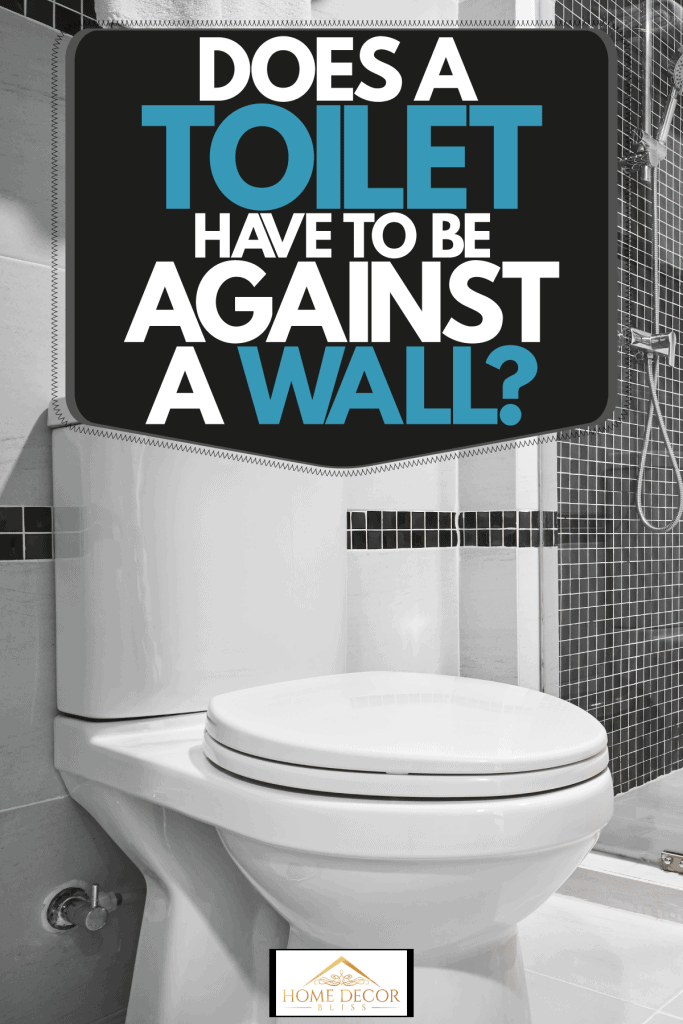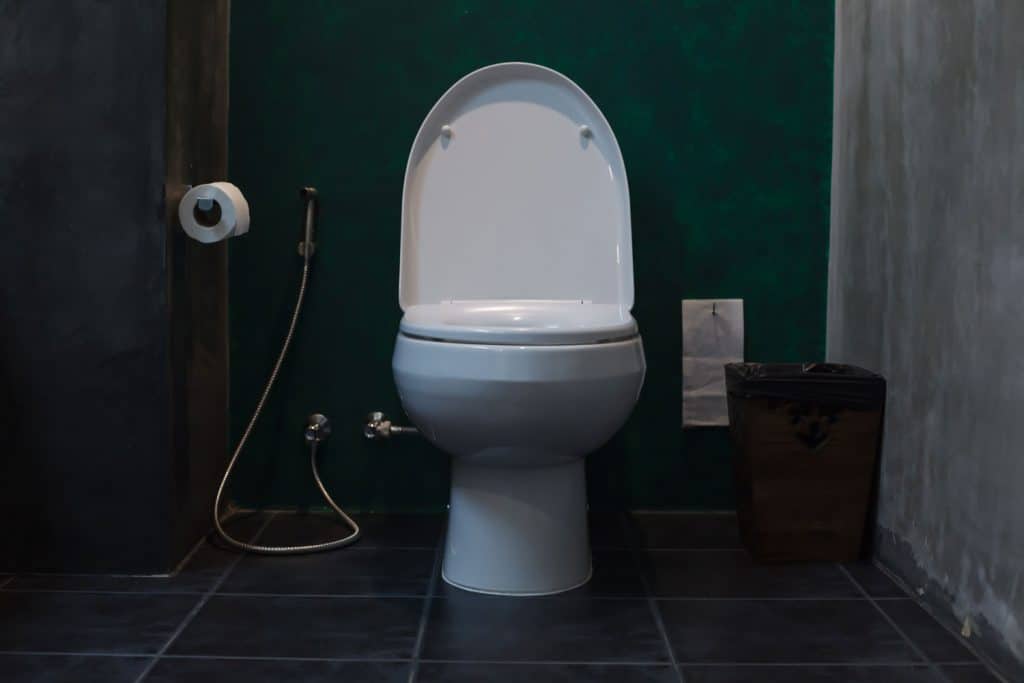The toilet is a significant fixture in a bathroom or water closet, so it must be placed for easy access. But, you may have questions if there are any standards regarding how close a toilet must be against a wall. We researched the standard distances for a toilet to be suitably positioned in a bathroom.
The distance between a toilet and the back wall is typically measured using the toilet flange. Toilets should have a minimum of 15 inches from walls that flank the fixture. A distance of 12 to 12.5 inches should be between the center of the toilet flange and the back wall. Before installing a toilet, ensure that you look up local building codes and start measurements for fixtures. Adjustments may be required according to the size of your bathroom, the layout, and chosen style of toilet.
Whether you intend to tackle a tricky toilet install or learn more about how and why your toilet should be placed according to expert recommendations -read on and learn more about this vital fixture.

Picture Perfect Toilet Placements
We sometimes add affiliate links and content that was curated and created by our team with the help of advanced ai tools to help showcase the best design styles.

The toilet is a major fixture in the bathroom, so it has to be placed in a good position for access when nature calls. Wall-hung toilets are a popular choice for homes with an elder adult for comfort, as they can be installed between 15 to 19 inches off the floor. Floor-mounted toilets are a more popular choice because they are inexpensive and easier to install but require more extensive cleaning. The distance between the toilet and a wall is determined largely by the style of the toilet installed, the bathroom's layout, and personal preference.
If your bathroom has a wall-hung toilet, the fixture will be mounted directly to the wall. Toilets that are floor-mounted often have a visible and direct pipe supply connection and a tank, which requires a minimum inch of space from the back wall. Typically, the most important measurement for a toilet and the back wall is the rough-in. Additionally, there must be enough clearance on either side of the toilet if there are surrounding walls or fixtures and the front of the bowl.
Installing A Toilet
When installing a toilet, please understand that you will need to take several measurements for good placement. Additionally, consider aesthetics, access for routine cleaning, and how your toilet will impact your personal hygiene and comfort.
Check out building codes and ensure your toilet is up to standard. The rough-in could range from 10 to 14 inches, and a toilet shouldn't be closer than 30 inches to another sanitary fixture from its center. The cold water supply line is vital for a toilet and should clear the base molding and be high enough from the floor. Ensure you have the toilet at a comfortable height if it is wall-mounted, or select a comfortable seat height if floor-mounted. And lastly, there should be enough clearance at the toilet's sides and front.
If you are worried about any gaps between the toilet and the wall, make the most of your space and consider installing a towel rack, shelving, hang plants, lighting, or appropriate bathroom artwork. Remember, the toilet you choose sets the mood of your bathroom and should contribute to your hygiene, health and look aesthetically pleasing.
Should The Back Of The Toilet Touch The Wall?
There is no hard-fast rule about whether a toilet should touch the wall, as it is a matter of personal preference. Some people are okay with a toilet tank's top touching the back wall, while others desire a minimum of one inch of space between the commode and the back wall. A toilet should ideally have a modest amount of clearance at the sides, but it can touch a back wall.
Check out this water-saving toilet on Amazon.
Can I Put A Toilet On An Outside Wall?
If you wish to install a toilet on an outside wall, it is best if you don't live in a region where below-freezing temperatures can occur. It is possible that pipes on an outside wall could freeze due to plummeting temperatures, and additional insulation may be needed. Any toilet placed on an outside wall should have the cold and hot water supply pipes insulated. The wall should receive proper insulation and ensure that any gaps where cold air can come in are filled to prevent frozen pipes.
How Do I Know The Rough-in Size For My Toilet?
It is important to know the rough-in size for your toilet so you can have a more seamless installation or make upgrades to your bathroom. The rough-in is the measurement between the wall and the back of the toilet and waste pipe's center. Before you can determine the rough-in, you should calculate for clearance on either side of the toilet, the space needed to place the flange from the back wall, where the water supply pipeline will be placed, and the space left for the front of the bowl.
The standard rough-in for a toilet is 12 inches, but some toilets have a rough-in of 10 to 14 inches. Check your measurements before you commit to purchasing and installing a toilet.
Are Wall-hung Toilets Problematic?
If you desire to have a wall-hung toilet in your bathroom, do your research and consider hiring a licensed and certified professional plumber or contractor for installation. Wall hung toilets are a popular choice in bathrooms because they are height adjustable, look modern and sleek, and save precious space. However, wall-mounted toilets are more expensive than floor-mounted toilets. Installation is a lot more complex with a wall-mounted toilet, and if executed improperly or the weight limit is breached, it could damage the walls.
Don't delay if you notice signs of leaking or the bolts for a wall-mounted toilet are not secure. When in doubt, call a professional for assistance.
Check out this gorgeous ceramic wall-hung toilet on Amazon.
How Difficult Is It To Relocate A Toilet?

If you are interested in relocating a toilet, leave it to the professionals if you don't have enough experience executing plumbing jobs or renovations. Relocating a toilet is not as simple as it looks because you may have to open up walls or ceilings, move pipes around, and adjust the surrounding flooring.
The best time to relocate a toilet is if you are already renovating a bathroom. Invest your money and time wisely and hire a certified, licensed plumber to relocate a toilet. Be prepared to spend around $2500 to $3,500 to move a toilet, as drains, pipes, vents, and flooring may require augmentation.
Read more, "How Much Space Do You Need For A Toilet?"
In Closing
We hope that you feel more confident about your knowledge of toilets. If you are interested in renovating a bathroom or installing a toilet, you need to know the standard measurements for the rough-in, allowances between the commode and walls, and other helpful information. When in doubt, choose a certified professional to assist with a toilet installation or renovation of your bathroom. Many toilets look like they will be a simple install but may require relocating pipes, adding insulation to plumbing and surrounding walls, or changing the flooring.
Before you go, don't miss out on these worthwhile articles:
Read More: What Is The Standard Toilet Room Size And How Big Is A Typical Toilet?


